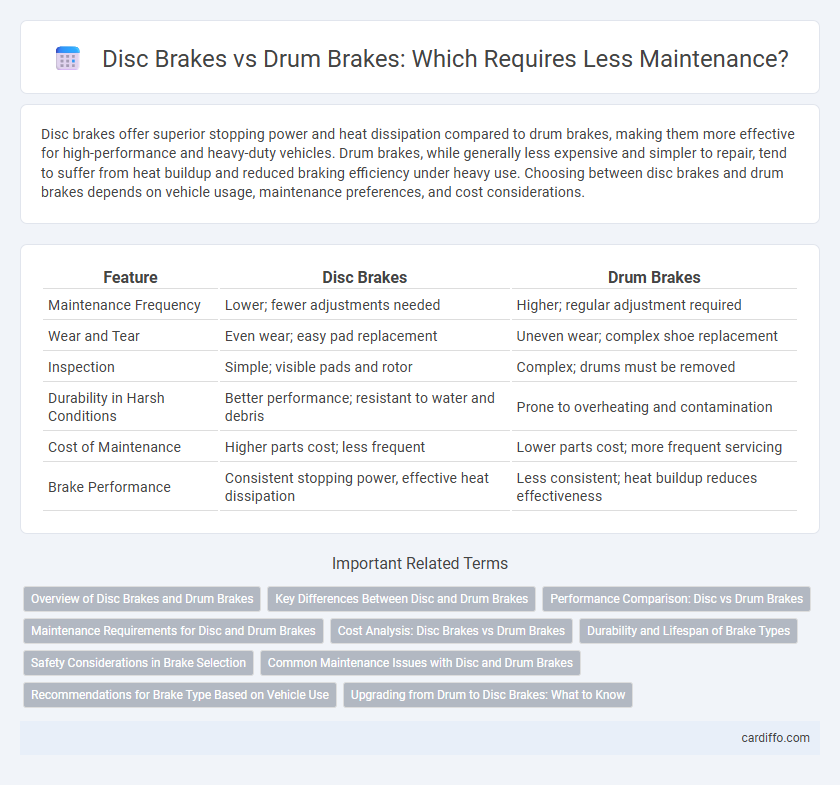Disc brakes offer superior stopping power and heat dissipation compared to drum brakes, making them more effective for high-performance and heavy-duty vehicles. Drum brakes, while generally less expensive and simpler to repair, tend to suffer from heat buildup and reduced braking efficiency under heavy use. Choosing between disc brakes and drum brakes depends on vehicle usage, maintenance preferences, and cost considerations.
Table of Comparison
| Feature | Disc Brakes | Drum Brakes |
|---|---|---|
| Maintenance Frequency | Lower; fewer adjustments needed | Higher; regular adjustment required |
| Wear and Tear | Even wear; easy pad replacement | Uneven wear; complex shoe replacement |
| Inspection | Simple; visible pads and rotor | Complex; drums must be removed |
| Durability in Harsh Conditions | Better performance; resistant to water and debris | Prone to overheating and contamination |
| Cost of Maintenance | Higher parts cost; less frequent | Lower parts cost; more frequent servicing |
| Brake Performance | Consistent stopping power, effective heat dissipation | Less consistent; heat buildup reduces effectiveness |
Overview of Disc Brakes and Drum Brakes
Disc brakes use a rotor and caliper system that provides efficient heat dissipation and superior stopping power, making them ideal for high-performance and modern vehicles. Drum brakes consist of a drum that houses brake shoes, offering a more cost-effective solution with better protection against dust and debris but less effective heat management. Both systems require regular inspection and maintenance to ensure optimal braking performance and safety.
Key Differences Between Disc and Drum Brakes
Disc brakes feature exposed rotors that provide superior heat dissipation and consistent stopping power, while drum brakes utilize enclosed drums that trap heat, leading to potential brake fade. Disc brakes generally require less maintenance due to their self-cleaning design and easier inspection compared to drum brakes, which often necessitate more frequent adjustments and can accumulate debris. In terms of performance, disc brakes deliver better responsiveness and are preferred in high-performance and heavy-duty vehicles, whereas drum brakes are more cost-effective and commonly found on rear wheels of standard cars.
Performance Comparison: Disc vs Drum Brakes
Disc brakes deliver superior stopping power and heat dissipation compared to drum brakes, making them more effective in high-performance and wet conditions. Drum brakes tend to suffer from brake fade due to heat buildup and provide less consistent braking force under heavy use. Maintenance efficiency also favors disc brakes, which are easier to inspect and replace, contributing to better long-term performance.
Maintenance Requirements for Disc and Drum Brakes
Disc brakes demand regular inspection for rotor wear and pad thickness, with pad replacement typically easier and faster compared to drum brakes. Drum brakes require frequent adjustments to maintain optimal contact and more complex servicing due to enclosed components, including checking shoe wear and wheel cylinder functionality. Proper maintenance of disc brakes generally results in better heat dissipation and consistent braking performance, while drum brakes often necessitate more labor-intensive upkeep to avoid brake fade and ensure safety.
Cost Analysis: Disc Brakes vs Drum Brakes
Disc brakes generally incur higher initial costs due to more complex design and materials like steel rotors and calipers, whereas drum brakes are more budget-friendly with simpler construction. Maintenance expenses for disc brakes tend to be lower over time, thanks to better heat dissipation leading to less frequent component replacement compared to drum brakes, which often require more regular adjustments and part changes such as shoes and drums. Total cost of ownership favors disc brakes for vehicles subjected to heavy use or high-performance demands, while drum brakes remain cost-effective for low-maintenance, budget-conscious applications.
Durability and Lifespan of Brake Types
Disc brakes generally offer superior durability and a longer lifespan compared to drum brakes, especially under high-stress conditions such as frequent braking or heavy loads. The exposed design of disc brakes allows for better heat dissipation, reducing the risk of brake fade and component wear. Drum brakes, while often more affordable, tend to wear out faster due to heat retention and the accumulation of brake dust, leading to more frequent maintenance and replacements.
Safety Considerations in Brake Selection
Disc brakes offer superior heat dissipation and more consistent stopping power, making them ideal for high-performance and safety-critical applications. Drum brakes, while cost-effective and durable under light use, are more prone to brake fade and reduced efficiency under heavy load or prolonged use. Choosing disc brakes enhances overall vehicle safety by providing reliable performance in diverse driving conditions and reducing the risk of brake failure.
Common Maintenance Issues with Disc and Drum Brakes
Disc brakes commonly face issues such as rotor warping, pad glazing, and caliper sticking, which can lead to uneven braking and noise. Drum brakes often suffer from shoe wear, drum scoring, and spring fatigue, causing reduced braking efficiency and the need for periodic adjustments. Regular inspection and timely replacement of components ensure optimal performance and safety for both brake types.
Recommendations for Brake Type Based on Vehicle Use
Disc brakes offer superior performance for vehicles used in high-speed or heavy-load conditions due to better heat dissipation and consistent stopping power. Drum brakes are recommended for lighter vehicles or those with minimal braking demands because of their cost-effectiveness and longer lifespan in low-stress environments. Selecting brake types based on vehicle application enhances safety, efficiency, and maintenance schedules.
Upgrading from Drum to Disc Brakes: What to Know
Upgrading from drum brakes to disc brakes significantly improves braking performance and heat dissipation, reducing fade during heavy use. Disc brakes require less frequent maintenance due to their self-cleaning action and more efficient water shedding, which enhances safety in wet conditions. Compatibility with existing wheel hubs and the need for appropriate caliper brackets are important considerations during the upgrade process.
Disc Brakes vs Drum Brakes Infographic

 cardiffo.com
cardiffo.com